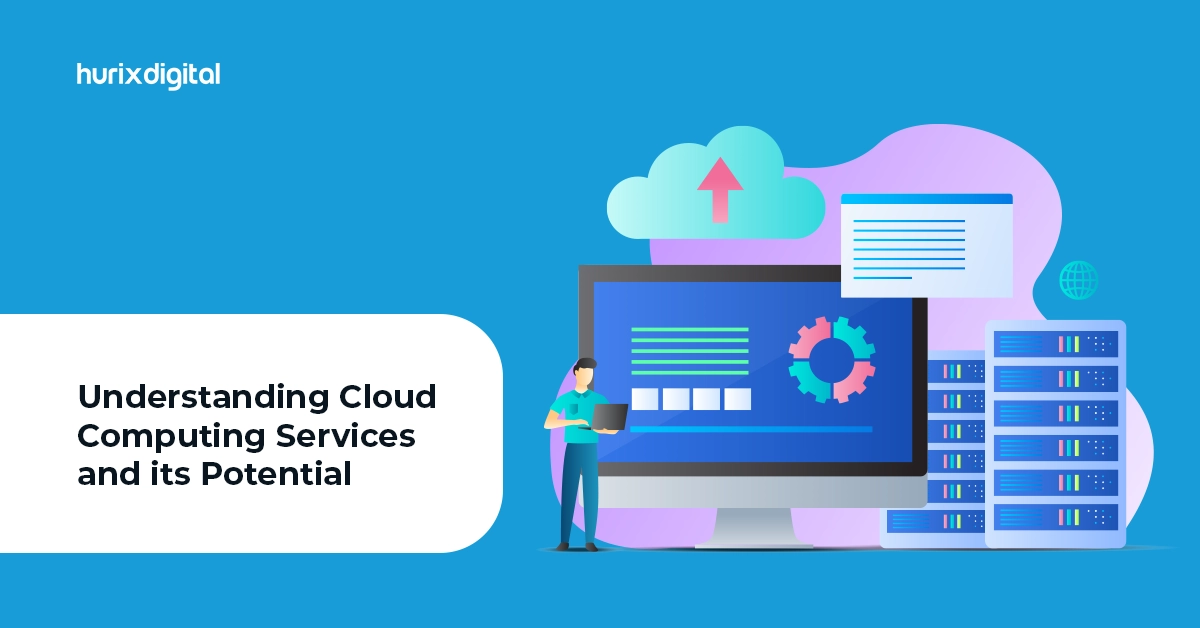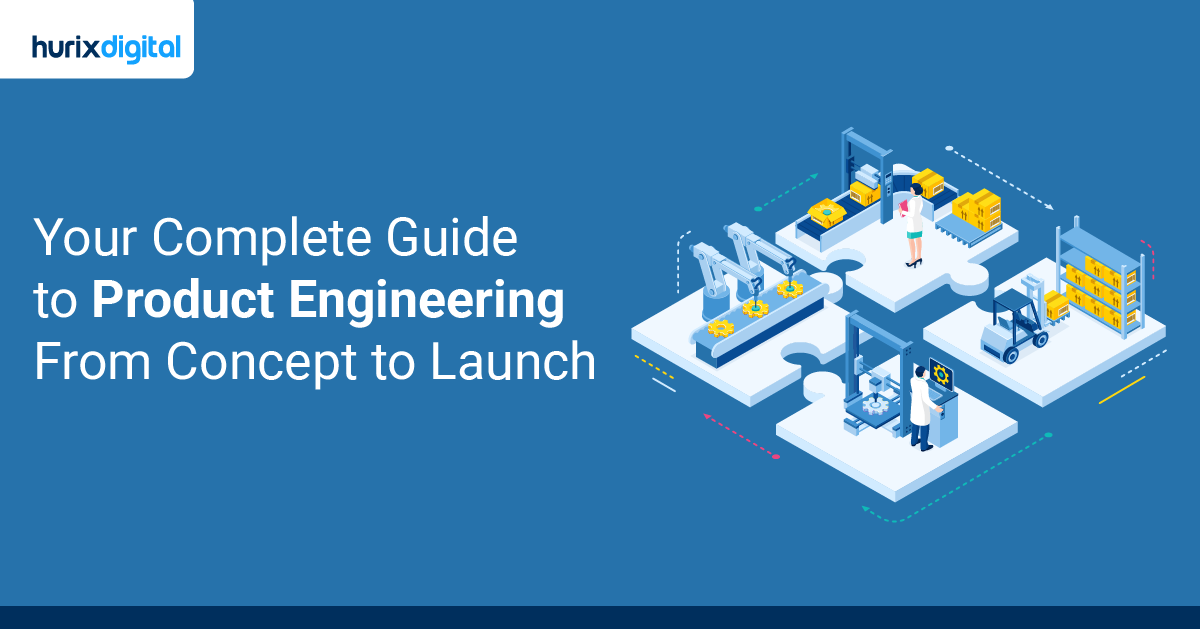
Your Complete Guide to Product Engineering From Concept to Launch
Summarize with:
It is not an easy feat to impress modern-day customers! That is why businesses worldwide are constantly engaged in various processes to launch newer and better products regularly to keep up with changing customer preferences.
Product engineering services are becoming increasingly popular in the contemporary business era. These services enable businesses to quickly create commercially viable products and launch them in the market. These service providers are consultants who create new products with improved features and enhanced functionalities using various tools and techniques.
This industry is ever-expanding, and the Product Engineering Services Market Research report predicts the global product engineering services market size is set to grow from $1085.8 billion in 2021 to $1610.6 billion by 2031. This indicates that it is no longer sustainable for companies to create and introduce new products with basic research. Companies must dive deep into industry research, provide value, and be prepared to invest in high-quality product development services.
Table of Contents:
- What is Product Engineering?
- What is the Role of Innovation in Product Engineering?
- What are the Main Areas of Product Engineering?
- What are the 5 Stages of Product Engineering?
- Types of Product Engineering Services
- Closing Thoughts
What is Product Engineering?
Product engineering is the process of innovating, ideating, designing, developing, and testing a product, device, software, or system that is then produced for sale. Product engineering is an extensive process that deals with quality, performance, production, reliability, serviceability, and other features. These product features are intended to make the resulting product more attractive to its targeted audience.
Product engineering entails the entire product life cycle, from the innovation phase to the production and user acceptance testing phase. Product engineering services aim to create new products designed to appeal to changing customer preferences and evolving societal trends.
It is difficult, as every product must be prototyped and undergo multiple quality testing rounds. As such, the importance of product engineering services cannot be understated.
What is the Role of Innovation in Product Engineering?
Rapid technological advancements are rendering products obsolete within a shorter period than before. Technology developments heavily impact product engineering services. Therefore, it is imperative to have a fail-proof approach to the process that can withstand the test of time.
Companies launch thousands of new products each year without knowing which ones will do well and which will fail. According to Harvard Business School professor Clayton Christensen, 95% of the nearly 30,000 new products launched each year end up failing.
Many products fail to perform because they do not appeal to the target audience. Products may also fail if they are poorly built, unsafe to use, too expensive, or not according to the target audience’s tastes. Even large and successful companies occasionally launch poorly-researched products in the market and suffer huge losses.
One way of developing products with a user-centered design that customers would love to buy is to invest in innovative product engineering services. Excellent product engineering focuses on the customer’s requirements while also considering the organization’s core values.
Due diligence is accorded to adding innovative features, security, scalability, testing, and deployment.
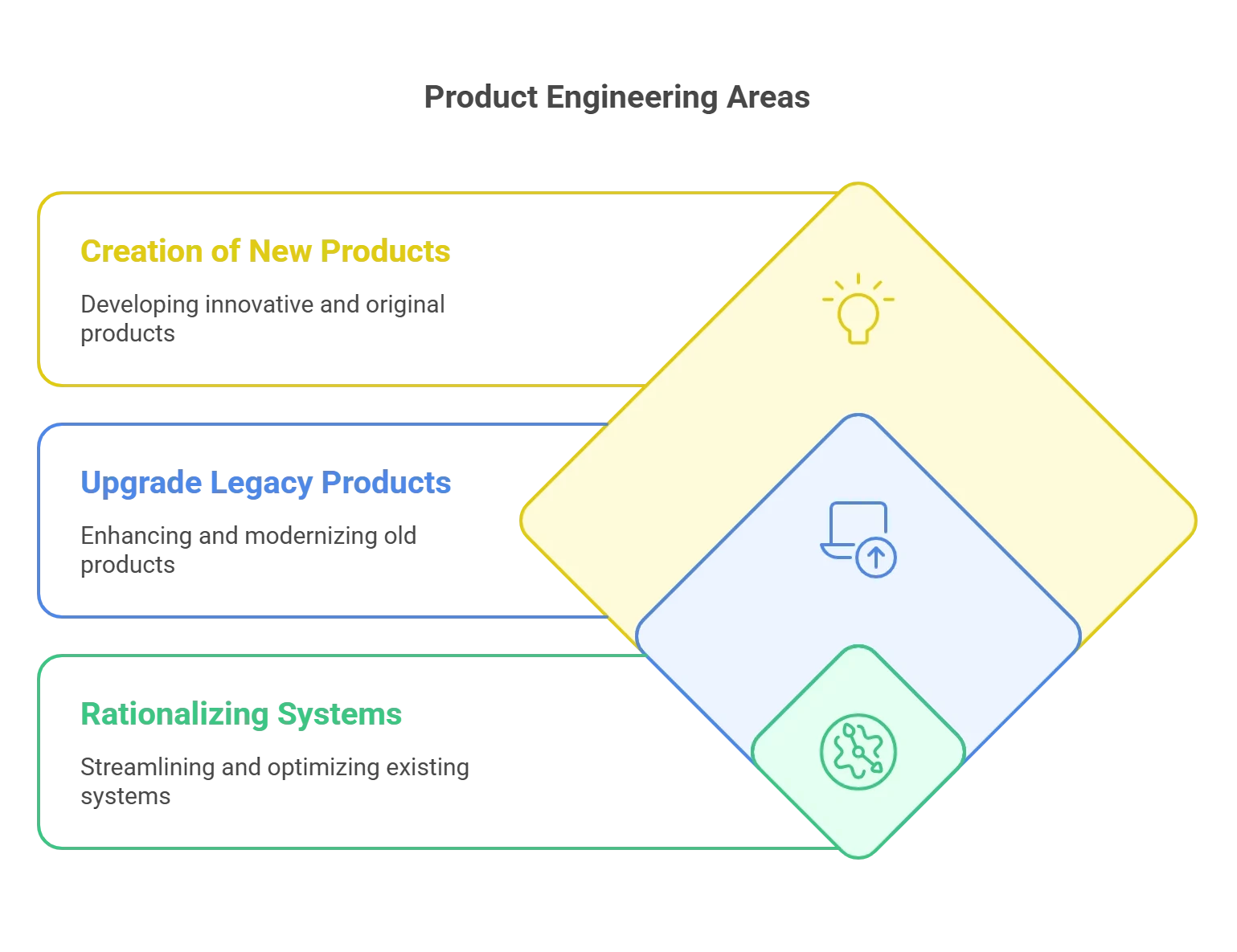
What are the Main Areas of Product Engineering?
Three significant areas of product engineering services call for a strong product development mindset.
1. Creation of New Products
Companies must constantly develop new products to cater to the changing demands of customers. No company can survive long with just a few products in its repertoire.
Creating new products is a major function of product engineering services.
- As the first step, product development teams explore ideas to find good ones that can be converted into manufactured products.
- Then, a prototype is created, and market testing is done.
- After many quality assurance checks, the product is finally produced for commercial sales.
2. Upgrade Legacy Products
Many companies have legacy products that have sold well for decades. However, these products must be upgraded after a few years to stay relevant. Modernizing traditional designs while staying true to the company’s legacy comes with several challenges that product engineering services must navigate. Integrating newer features into the existing product design while considering the budget constraints is a major challenge.
3. Rationalizing Systems
Product engineering services can’t be implemented in a vacuum. Organizations must create several disjointed systems for every phase of the product engineering services process. The company must also ensure that these disjointed systems work in tandem to ensure the process is implemented smoothly. A strong network of systems needs to be in place so that good quality, meaningful new products are produced regularly.
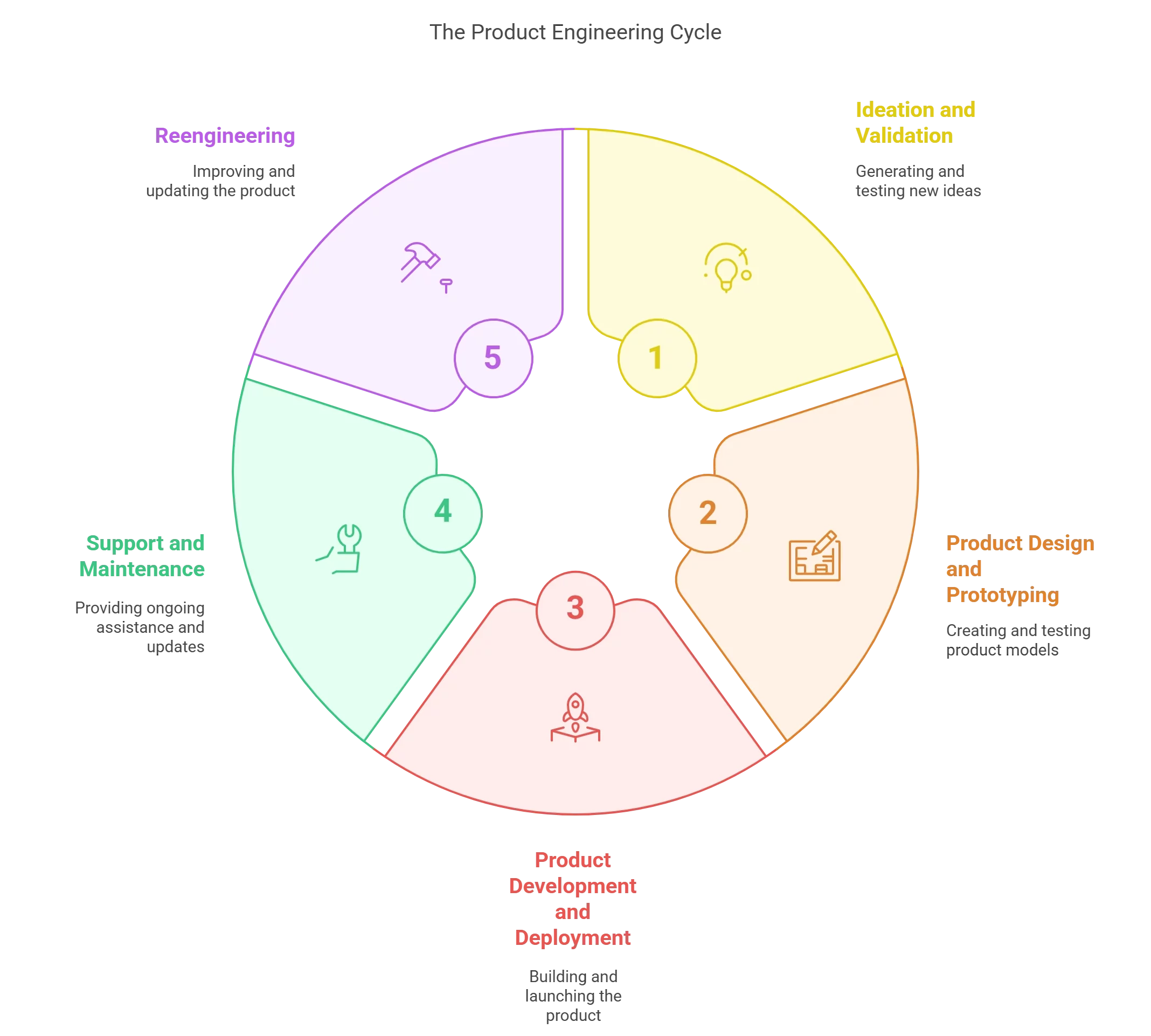
What are the 5 Stages of Product Engineering?
As mentioned earlier, the product development process follows a series of well-defined phases. When it comes to the digital world, the product engineering stages are as follows:
Stage 1 – Ideation and Validation
The ideation phase is the origin point of any new product. This is the phase where the flow of ideas and creativity is unrestricted. The ultimate goal of this phase is to brainstorm every aspect of the product in question.
This involves evaluating similar products already in the market, i.e., performing extensive competitor research, understanding how your target audience responds to them, and identifying any points your product can address.
While this phase seems simple on the surface, it can be pretty challenging once you dive into its intricacies. That said, specific strategies and frameworks exist that can help kickstart this process.
One effective technique is called the SCAMPER method. This method encourages thinking outside the box by innovatively reimagining existing products and services. Each product element is examined and subjected to various actions: Substitute, Combine, Adapt, Modify, Put to other use, Eliminate, or Reverse.
For example, you could already have a product that doesn’t work well in one scenario but may excel in a different market. You could also consider merging one or more of your existing production into one that can perhaps be a one-stop shop to address multiple pain points.
Another invaluable technique is to perform a SWOT analysis of your product. SWOT stands for Strengths, Weaknesses, Opportunities, and Threats and is a tried-and-tested strategy for determining how your product fares against its competitors.
Stage 2 – Product Design and Prototyping
Now that you have an idea that seems feasible and has been validated, product design is the second stage of the product development process. This is where your product starts to take shape regarding its technical, functional, and visual architecture.
When talking specifically about digital products, this stage involves creating wireframes and then mockups of the product’s UI/UX design. An extensive amount of time and effort is put into perfecting user flows and the technical and functional aspects of the product.
The end goal of this phase is to create a prototype of a Minimum Viable Product (MVP), which can then be put through a series of rigorous tests to get valuable feedback from target customers and stakeholders. The input and changes are incorporated, and the process is repeated until the product is ready to progress to the next stage in the product engineering cycle.
Stage 3 – Product Development and Deployment
In the product development stage, all the time and effort put into the previous stages culminate into a tangible and functional product.
This phase begins with extensive planning determining the best technology stack, framework, and architecture for this specific product. In terms of methodology, agile product development is the gold standard today.
Once a viable plan is in place, a crack team of product managers, technical architects, designers, and developers codes and develops the product.
Testing and Quality assurance also play a vital role here. A dedicated team of testers and QA engineers focuses on rigorous testing and validation to ensure that the developed product aligns with the design specifications and exhibits high levels of usability. Once the product is given the green flag, it is launched to the market.
Stage 4 – Support and Maintenance
Support and maintenance are vital in ensuring your product delivers value throughout its life cycle. The world of technology never stands still; existing technologies may become redundant.
Bugs that slip through the test phase may appear once the product has been released into the market, or the client may need new or improved features.
A digital product needs continuous improvement, one of the key pillars of Agile product development.
Stage 5 – Reengineering
Product engineering is not a fire-and-forget exercise. You can’t just launch a product and expect it to succeed without further effort. It needs constant improvement based on user feedback, market trends, and technological changes.
That is where the reengineering phase comes in. In this phase, the product is redesigned or redeveloped to meet new requirements or overcome existing limitations. This is a critical phase as it helps maintain the product’s competitiveness in today’s dynamic and volatile market.
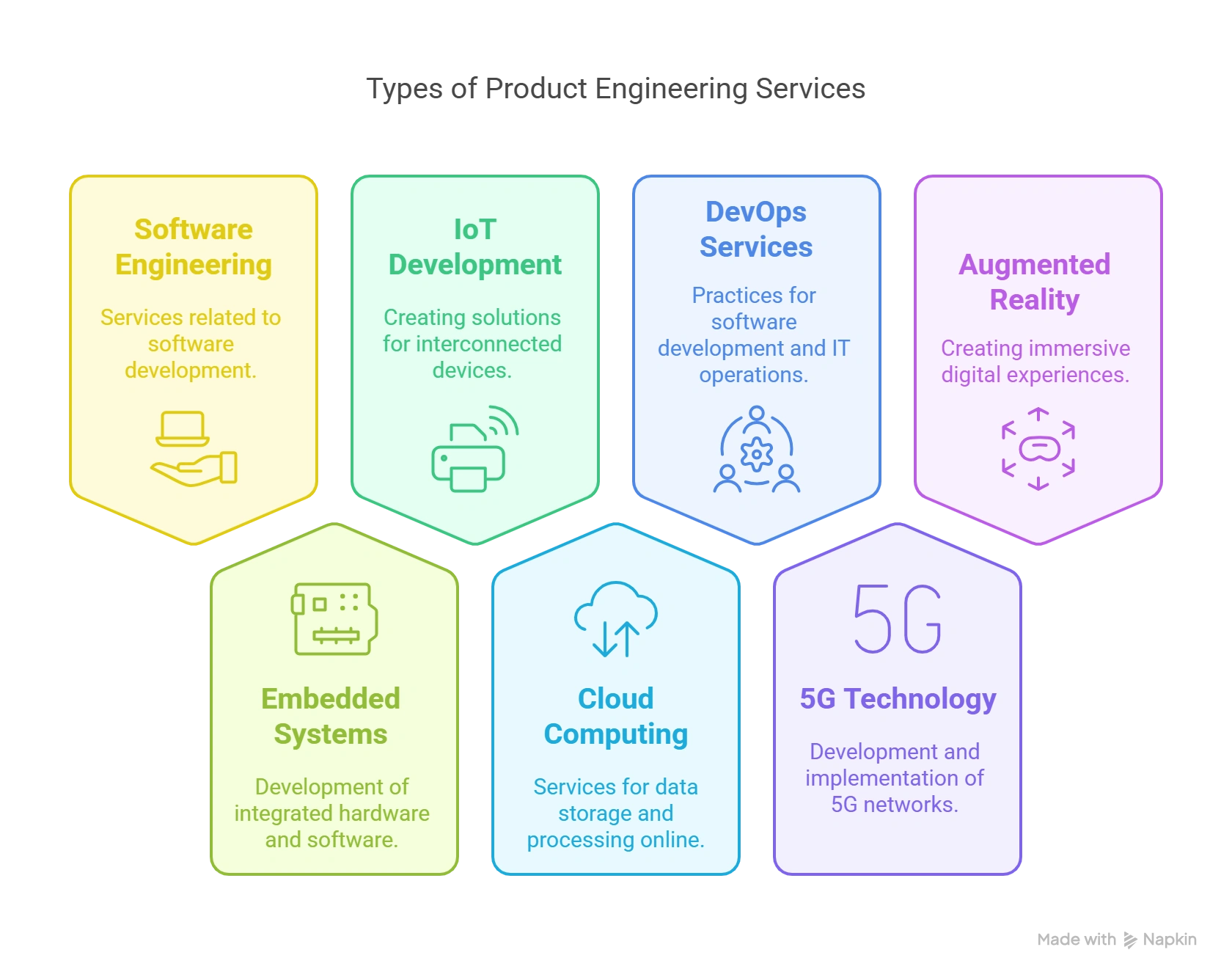
Types of Product Engineering Services
Product engineering services encompass a vast array of services ranging from software and embedded systems development to IoT and cloud computing services.
1. Software Engineering Services
Software engineering services include researching, analyzing, and creating computer operating systems and software programs. These services focus on optimizing the systems and programs of a business and ensuring that they run efficiently without any hindrances.
Software engineering services can encompass agile software development, digital platforms, and quality assurance. They can also include software integration engineering and security engineering.
2. Embedded Systems Development Services
Embedded systems software programs are specialized programming tools in embedded devices. These programs facilitate the functioning of the machines and manage hardware systems and devices. Embedded software controls the functioning of a specific set of hardware devices while ensuring the highest levels of efficiency.
Embedded systems software can function independently on preset parameters without requiring human inputs from time to time. The software can be calibrated according to the organization’s needs and connected to other devices.
3. IoT Development Services
IoT development involves creating, designing, developing, and deploying IoT applications and products. These services also include implementing coding tasks and configuration required to build and maintain IoT solutions’ different software and hardware aspects.
Custom IoT development services cater to a business’s specific requirements. IoT development may encompass cloud programming, security, hardware device programming, systems engineering, networking, and more. It is highly collaborative and needs to be robust, scalable, secure, and user-friendly.
4. Cloud Computing Services
Cloud computing refers to the online delivery of various computing services and resources on demand. These include servers, applications, databases, software tools, networking, etc. Cloud computing services allow organizations to pay only for the resources they use, thus helping to reduce operating costs.
Cloud-based storage lets you save files to a remote database instead of proprietary hard drives or local storage devices. These files can be accessed anytime through the Internet. Cloud computing offers many benefits, including cost savings, higher productivity, improved speed and efficiency, and enhanced performance.
5. DevOps Services
DevOps is a delivery model designed to enhance productivity at different stages of the software development lifecycle (SDLC). It involves extensive planning, coding, testing, deploying, and monitoring of the SDLC to enhance its overall productivity.
DevOps services include creating software programs that fully satisfy user requirements and perform well. These services ensure the organization can successfully implement strategies such as continuous delivery (CD) and continuous integration (CI) to achieve business goals.
6. 5G Technology
The 5G technology will open up a whole new world of applications and products, changing the way companies do business. It offers lower latency, enhanced network capacity, and faster data transfer, enabling companies to stay innovative and competitive in their respective industries.
With enhanced data transfer speeds and connectivity, 5G technology can help you provide exceptional customer experiences. For instance, 5G allows faster checkout processes in the retail industry. 5G technology allows you to transfer data faster by improving network performance and connectivity. It is predicted that 5G technology will cover up to 85% of the world population by 2028.
7. Augmented and Virtual Reality
AR and VR in product engineering are changing how products are designed, developed, created, and manufactured. They are lowering development costs, speeding up design processes, and enabling more in-depth product testing in immersive digital environments.
You can iteratively test multiple product variations in an AR and VR environment rather than creating several physical prototypes. This expedites the design process and leads to a faster product development and delivery turnaround. With AR and VR, you can achieve detailed visualization with precision early in the design process. As no physical materials are needed until the final stages, this significantly reduces investment costs.
2D renderings make it impossible for designers to determine how a design will work in the real world before developing a physical prototype. However, with AR and VR, designers can drop designs into the real world, where they can experiment with them at scale.
Closing Thoughts
The smooth and effortless implementation of product engineering services is imperative to the long-term success of any business organization. These services are required to create new products, update existing legacy products, and build a robust system that supports the innovation of new meaningful products.
Contemporary companies employ several types of product engineering services, including software engineering services, embedded systems development services, IoT development services, and cloud computing services, to stay relevant in the marketplace.
Are you looking to upgrade the product engineering services process in your organization? With more than two decades of experience in the IT and education sector, Hurix Digital is your best bet to outsource all your product engineering needs. Contact our experts to discuss your organization’s product engineering requirements and build a brilliant system that caters to your unique needs.
Summarize with:

Vice President & SBU Head –
Delivery at Hurix Technology, based in Mumbai. With extensive experience leading delivery and technology teams, he excels at scaling operations, optimizing workflows, and ensuring top-tier service quality. Ravi drives cross-functional collaboration to deliver robust digital learning solutions and client satisfaction
 Upcoming Masterclass | Build an Army of Brand Evangelists using Training & Development | November 20th, 8:30 AM PDT | 11:30 AM EDT | 10:00 PM IST
Upcoming Masterclass | Build an Army of Brand Evangelists using Training & Development | November 20th, 8:30 AM PDT | 11:30 AM EDT | 10:00 PM IST

